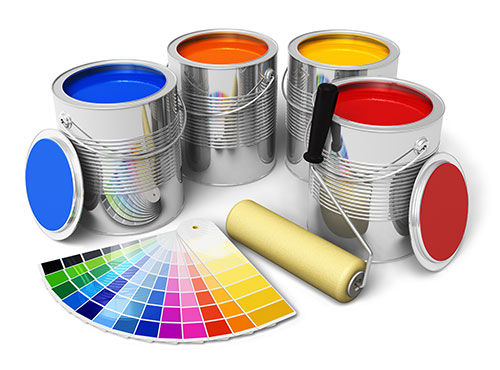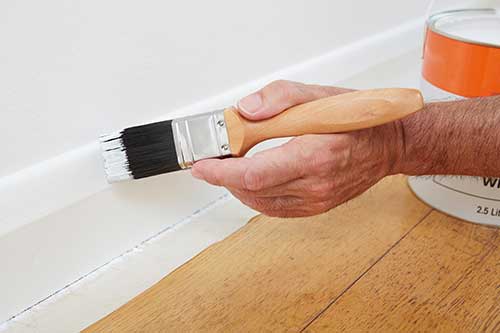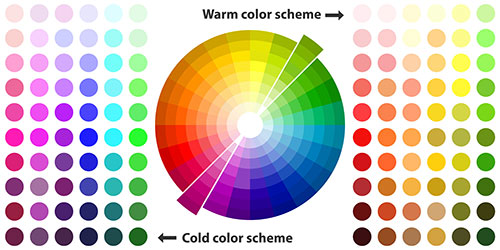Types of Paint
 Different types of paint have been around for many ages. The oldest archeological evidence of paint was found in Blombos Cave in South Africa. They found an ochre mixture dated 100,000 years and a grinding tool dated 70,000 years old in the caves.
Different types of paint have been around for many ages. The oldest archeological evidence of paint was found in Blombos Cave in South Africa. They found an ochre mixture dated 100,000 years and a grinding tool dated 70,000 years old in the caves.
Painting enhances the look of any home. But not just any paint; the right type of paint with an appropriate sheen can work wonders. It has a significant effect on the character and the design aesthetic of the room. As such, many factors play an essential role in the choice of paint and color.
This guide brings you everything you need to know about the different types of paints, finish, how to choose the right kind for your wall, and many more.
Different Types of Paints
Based on the base, paints can be of three types:
- Oil-based
- Water-based
- Latex-based
Types of Paint – Oil-Based Paint
Otherwise called solvent-based paints, oil-based paints have solvents as the base. The presence of solvents makes for odor and fumes; they are also hazardous to work with.
Oil paints are a great choice if you look for more resilient and durable paints with a creamy finish. Not only are they inexpensive, but they also stand the test of time without showing any signs of damage, wear, and tear.
They have better adhesion and surface penetration than other paints. Their stain-resistant properties make it suitable for metals, bleeding woods, and surfaces that get stained easily.
Oil-based paints are used for areas such as trims because they can withstand abuse and stay vibrant for a long time. But they tend to take a longer drying time. However, considering the advantages, the wait is worth it.
Other than that, oil paints also require specially designed brushes and rollers. Cleaning is also not easy since water doesn’t cut it. You need to use turpentine or paint thinner.
 Advantages
Advantages
- Brushstrokes fill themselves to create a smooth finish.
- Durable
- Attractive gloss
- Good for rooms with high humidity
Disadvantages
- They release VOCs, which are harmful to the atmosphere.
- Difficult to wash
- They can separate quickly.
- The application is messy.
Types of Paint – Water-Based Paint
Water-based paints have water as the base and hence do not emit any odor and obnoxious fumes. This makes it ideal for interior painting. They also dry quickly between coats making it easier to get a lot done in one day.
Though not stain-resistant, they can be cleaned easily with a little soap and water, unlike oil-based paints. Moreover, the shine, richness, resilience, and durability are also missing here.
Water-based paints go smoothly on all surfaces except for those which have oil paints. In this case, you might want to use sandpaper to rough them up, eliminate the shine and then paint.
You might want to look into a couple of new entries, waterborne enamel or waterborne alkyds. Both of them behave much like oil-based paint but without toxic fumes. They also level easily and have a smooth finish.
 Advantages
Advantages
- No/low VOC
- Easy cleanup
- Dries quickly
- No mildew growth
- No need for pretreatment
- Elastic finish, resistant to cracks
- Color doesn’t fade
Disadvantages
- Each finish is not as vivid or rich.
- Not long-wearing
- Can peel off from the walls when damp
- Expensive
Types of Paint – Latex-Based Paint
Though interchangeably confused with water-based paints, latex-based paints have a better shine (buildable). It is also non-toxic and environmentally friendly. The order doesn’t stay as long; however, adequate ventilation is required.
They are easy to apply and don’t make as much a mess. Latex paints also do not trap moisture but expand and shrink with the temperature changes; hence need lesser drying time as well;
Having said that, the same paint cannot be used in both interior and exterior. You need specially designed paints, particularly for the exterior. Paint formulated for interiors cannot hold up outdoors.
- It doesn’t peel or crack.
- Prevents the formation of mold and mildew
- Dries fast (but only superficially)
- Easy to clean with water and soap
- Nonflammable
- Less color fading and no yellowing
Disadvantages
- Needs primer for a smooth finish
- Steel and wood need more primer.
- Shrinkage
- Curing time takes weeks; hence can damage easily.
- Sensitive to temperature change
Differences in Water-Based, Oil-Based, and Latex Paints
The choice of paint plays an integral part in elevating the look and bringing a fresh appeal. But not all paints work the same; here are the differences between the different types of paint:
Durability: Oil paint is the most durable of them all, followed by latex and finally water-based paint.
Drying Time: Water-based paint dries quickly while oil-based paint takes at least 24 hours, and latex is much closer to water in terms of drying.
Finish: Oil-based paints have the best finishes of them all, with latex closely following. They have a high gloss and shine with vibrant colors. Water-based paint needs a bit of maneuvering to get a smooth finish and don’t have the qualities of oil paints.
Ease of Work: Water and latex paints are easy to work and clean with, but oil-based paints are particularly messy. They need turpentine or paint thinner.
Types of Paint Finishes
Paint finish refers to the amount of light reflected by the painted surface. Paints with a sheen reflect light while the others absorb light. And as such, it can be of two broad categories.
- Flat or matte finish has no sheen hence absorbs light.
- Semi-gloss and gloss paint reflects light giving them a brilliant shine.
There are five different types of paint finishes.
- Flat/Matte: Matte finish reflects the least amount of light but provides the most coverage, even concealing nail holes and such. However, they are least reliable and hence apt for areas that do not have much traffic like your dining room and those that aren’t touched much like your walls and ceilings.
- Eggshell: One of the most popular finishes with a lustrous shine and slightly better than matte paint. They have better durability but not as much when compared to a glossy finish. They are best used in low traffic areas like your living room, entryway, etc.
- Satin: The most common of all finishes, the satin has a velvety sheen and is easier to clean. They are good for high traffic areas such as family room, kitchen, bathroom, playroom, etc.
- Semi-gloss: Quite shiny and reflective, the semi-gloss paints are durable and used in rooms that are high in humidity, such as bathrooms, or receive much more wear and tear than other rooms like your kids’ rooms.
- High-gloss: Shiniest of the bunch, the high gloss paints are tough, waterproof, and washable. They are used for doors, cabinets, trims, etc. However, the prep work is essential for this finish since it shows the imperfections clearly.
Tips to Consider When Choosing a Paint Finish
 At first sight, the finish looks like more of design consideration, but in truth, the right paint sheen can brighten and increase the appeal of the room.
At first sight, the finish looks like more of design consideration, but in truth, the right paint sheen can brighten and increase the appeal of the room.
Here are a few tips to help you choose the correct finish:
Traffic: Consider the traffic in your room before choosing the finish. For rooms with heavy foot traffic or accelerated wear and tear, you’d want to look into semi-gloss or even satin paint. They are durable and can last long. However, calmer or isolated rooms can get away with eggshells or even flat paint.
Sheen: In case your room has plenty of natural light that you want to reduce the glare, go for a matter. However, for a darker room, you’d want semi-gloss paint to reflect the light and brighten the room.
Blemishes: A flat paint can hide imperfections better than any other finishes. On the other hand, a glossy finish can highlight the surface defects. So, if your walls are not smooth, you may want to go with a flat or a matte.
Right Types of Paint for All Materials
Depending on your project, you may have to paint on various surfaces. And not all paints work the same for every material.
Make it a point to prep the surface with a primer unless mentioned otherwise. Here a quick update on the different applications:
- Brick: High-quality latex paint
- Concrete: Prep using a primer specially formulated for concrete and continue with a latex primer
- Ceramic / Porcelain Tiles: An acrylic primer followed by acrylic paint for interiors
- Concrete Block: Start with a sealer and continue with high-quality acrylic latex primer and then acrylic latex paint.
- Fiber-Cement Siding: Exterior paint.
- Fabric: Water-based paint
- Fiberglass Doors (Exterior): An acrylic latex primer and finally, the exterior-grade latex paint
- Countertops: Primer formulated for non-porous surface and acrylic latex enamel
- Metal: Paint formulated for metal
- Plastic: Exterior grade acrylic enamel
- Vinyl Shutters: Latex-based paint
- Wicker: exterior-grade acrylic latex paint
- Wood: Two coats of stain-blocking primer followed by latex-based paint
Best Types of Paint for Interior Walls
The condition in every room of your home isn’t the same. The humidity in the bathroom would not be present in the bedroom; The spill and stains in the kitchen warrant durable paint, while the living room needs something more elegant.
Every paint comes with a different set of properties and functionalities. Here is a paint guide to help you choose the right type of paint.
- Kitchen Walls: Kitchen walls are prone to stains; hence a latex enamel with satin or eggshell finish is preferred. You can also go for semi-gloss if you are worried about maintenance.
- Bathroom Walls: The bathroom is high in humidity and moisture. So, it helps to have latex enamel paint with a glossy finish.
- Ceilings: Ceilings reflect the necessary light in the room. A flat white latex-based paint gives the illusion of space, making the room appear larger. Avoid gloss paint for ceilings as they provide a space limiting illusion.
- Trim, Cabinets, Windows, and Doors: Oil-based paints like alkyd or acrylic latex suit the wooden surface as they give a smooth finish. Even though the oil paint gives out fumes, the payoff and also long-lasting are worth it.
- Living Rooms, Dining rooms, and Bedroom Walls: An acrylic latex-based paint with either a flat or an eggshell finish work best with the living room and bedroom.
Best Paint for Interior Painting
The paint you use for your interior should give a rich finish with buttery smooth walls and easy to clean.
As such, here are the best paints in the market:
- Sherwin-Williams Cashmere – Goes on buttery smooth with a silky and creamy finish.
- Glidden Essentials Interior Paint – Best budget paint with excellent coverage and low VOCs
- Backdrop Standard Finish Interior Paint – Premium water-based paint with acrylic resin works well with all the walls delivering a low-sheen, semi-matte finish.
Best Type of Paint for Trim
 Even though trims occupy a small part, it serves a decorative purpose and calls attention to itself. Hence the paint that you use should highlight the details. Apart from the visual aspect, they are also high-impact areas; The types of paint you use for trim should be able to withstand the bumps and nicks.
Even though trims occupy a small part, it serves a decorative purpose and calls attention to itself. Hence the paint that you use should highlight the details. Apart from the visual aspect, they are also high-impact areas; The types of paint you use for trim should be able to withstand the bumps and nicks.
- Oil-based paint with its thick consistency fills in all the cracks and blemishes in the trim. Since it has a longer drying time, it settles properly and dries into a uniform layer.
- Also, keep in mind that the choice of paint varies depending on the location. So, you might want to get interior or exterior paint accordingly.
- Satin, gloss, semi-gloss, and high gloss work well for trim. However, semi-gloss paint seems to be the industry standard. It is smoother than satin and also hides imperfections better.
- White is the most common and versatile color for trims. However, you can also use neutrals for subtle elegance and bold color for a visual impact.
Important Qualities to Look for in Exterior Paint
Exterior paints not only give a fresh look to your home but also protects it from external elements. It withstands the barrage of rains, icy winters, scorching summers without cracking, peeling, or fading.
Here are some pointers you may want to consider before buying exterior paint.
- Durability: With regards to exterior paint, you get what you pay. Expensive paints have good additives, better pigments, and above all, they come with a good warranty of at least 15 years.
- Drying Time: The drying period depends on the type of paint you use. You would have to wait until the first coat is completely dry before painting the second coat. Though latex-based paints dry within a couple of hours, they need at least 4-6 hours of curing time before a second coat is applied. However, you need at least 24 hours for oil-based paint to cure before you paint the second coat, even though it dries within 6-8 hours.
- Low VOCs – Since the 1950s, The United States had regulated the emission of VOCs from the oi-based paints. Oil-based paint emits toxic fumes, which might cause headaches and nausea. So, you may want to buy one that is low-VOC or No-VOC.
- Long-Lasting Color: Your exterior paint will be subjected to direct sunlight and UV radiation which wreak havoc on the color. Good quality paint will have pigments that don’t fade over time. The fading also depends on the color; Darker colors are likely to fade away quickly than their lighter counterparts. For darker shades, choose a paint with titanium dioxide as an ingredient.
- Weather Resistant: A good exterior paint should handle the extremities of weather and resist it for years to come. The acrylic-based latex paint can repel rain without becoming brittle, crack or peel. While most paints will have some amount of acrylic, you may want one advertised as all acrylic to reap its benefits.
- Climate Compatibility: Buy a paint that suits the climate in your region. For example, if you live in desert regions like New Mexico, you may want to buy UV-resistant paint, while in Louisiana, paints need additives to prevent mold and mildew.
- Surface Suitability: The paint you use for the exterior should be compatible with the surface you are painting on. With your siding already painted in latex, go for latex since oil can melt the latex and cause the paint to peel.
Best Type of Paint Suitable for Exterior
Acrylic and oil-based paints are the most suitable of them all since they are both durable and long-lasting. Acrylic works well on sidings (such as wood, aluminum, fiber cement, etc.), plaster, stucco, drywall, etc.
Oil-based paint has long been the choice for exterior walls due to its shine and enduring nature. However, with the development of acrylic-based latex paints, they have become the favorite of painters, DIYers, and pros alike.
Paint Colors that Boost Home Value
A new coat of paint gives the prospective buyers a good impression and a sense of satisfaction that it is well taken care of. The right paint color makes your home more attractive and helps it sell faster for more value.
A new paint job in colors such as grays, whites, neutrals, and light pastels such as soft muted pink, sage green, works well for your home in times of sale.
Tips for Picking Paint Colors
Painting your home in the right color is only half the job. The most important part is to choose a suitable paint color.
 Here are a few insider tips to choosing the right color:
Here are a few insider tips to choosing the right color:
- Choose paint based on the lighting.
- Start your painting experiment from a small nook.
- Choose the color based on the finish.
- Play with neutral paint colors.
- Get outdoors for ideas.
- Consider the undertones to find the right paint color.
- Find inspiration in artworks.
- Choose different types of paint and finishes.
- Sample the colors before painting.
- Use a color consultant.
Conclusion
There are different types of paints and paint finishes; their application varies greatly depending on the surface and temperature.
Oil-based paints are glossy that hides imperfections but are not suitable for interiors due to their emission of VOCs. On the other hand, water-based is quite popular since they are environmentally friendly. They pretty much anywhere.
Coming to sheens, matte paint has gone on thickly and fills in all the cracks but is not durable. But gloss finishes like semi-gloss and high gloss are durable, easy to clean, and also reflective.
Not all paints work the best in every room. You need to use the right finish based on the lighting, humidity, and traffic.
While the types of paint are often considered to be a design element, it is far from the truth. It provides protection to the surfaces, increases durability, and also easy maintenance. And that is where Wiese Painting Contractors can help. With over 65 years of experience in residential and commercial painting services, we are confident that you’ll love our work. Contact us for your free quote today!
Other timely articles you may find helpful:









